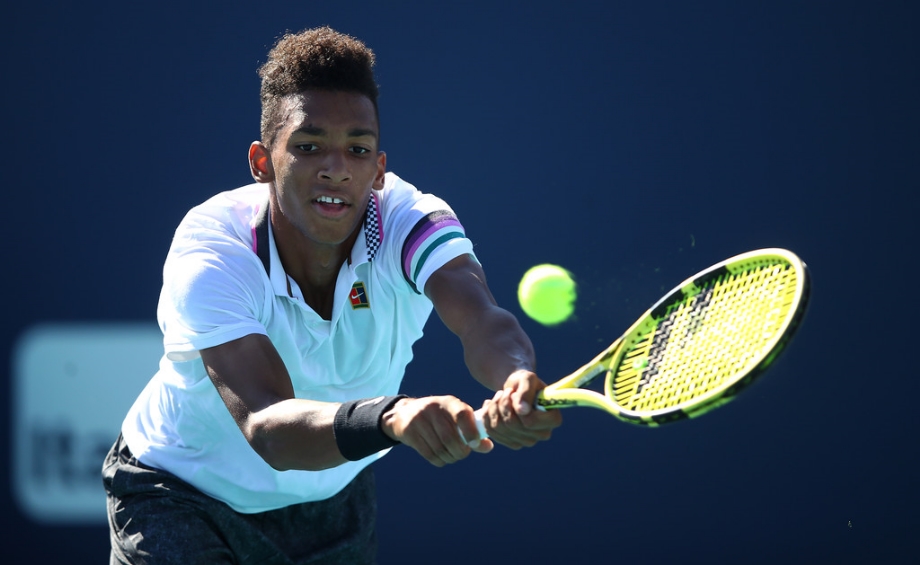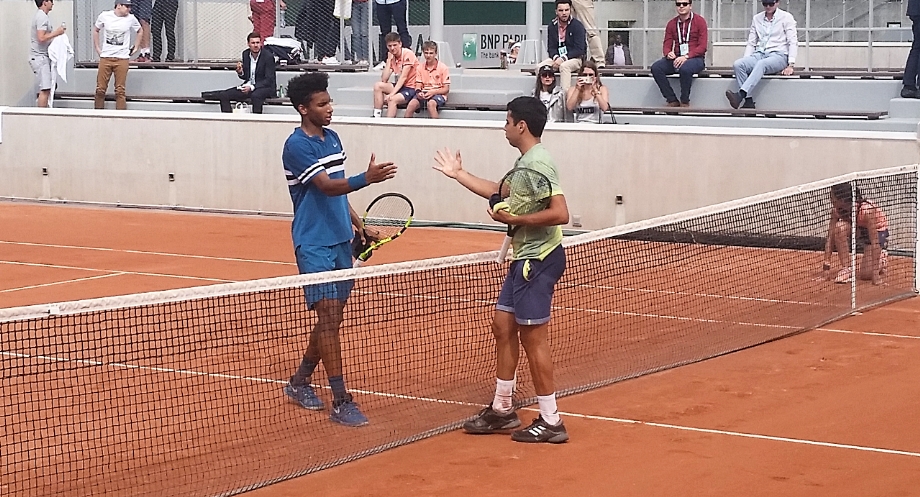Auger-Aliassime, the 18-year-old Canadian reached the quarterfinals of Miami Open ATP 1000 event, by defeating Nikoloz Basilashvili 7-6 6-4 in a tightly contested match, but only sporadic in quality.
I felt that this was a fascinating encounter in that both players sport similar plan “A”s, i.e., seeking to direct rallies from the baseline and avoid patterns that can lead to defensive scrambles. Basilashvili can dazzle with his strike power – 90-95 mph winners from the baseline are not unusual for him – and Auger-Aliassime is a nightmare to defend against if he is allowed to play on or inside the baseline from where he can run his opponents to exhaustion. Furthermore, both have powerful first serves behind which they can set up shop, so to speak. The question was, which player would more effectively use his strength to expose the other’s weakness? I must also admit that my anticipation level was raised instinctively because I am a fan of both players.
Unfortunately, it did not live up to expectations – for me, at least – as both players struggled with unforced errors and missed opportunities. It turned, instead, into a battle of who could avoid errors or perform better on important points.
Let’s begin with the very first game. Three times in that game Niko turned the rally in his favor and put himself in a position to win only to produce an unforced error to lose them. The biggest one came on a break-point opportunity at ad-out when he set himself up perfectly for a short-ball opportunity, yet netted the routine forehand put-away attempt. Looking back, this seems like a minor point considering the scope of Basilashvili’s troubles for the rest of the match, but it turned out to be his only break-point opportunity in the first set in which he had an easy crack at winning the point. Credit goes to Félix for coming up with the goods in the others.
Unforced errors kept coming in bunches for the Georgian who finished the first set with 18 of them (my count), not including his two double faults. Auger-Aliassime, for his part, did not fare much better, recording 15 unforced errors himself, plus three double faults.

Thus, either player’s success became dependent on which one could do a better job of mentally remaining resolved and brushing off the disappointments, because disappointments, there were many. At a certain point, it almost seemed like one player could rely on the other to blow a chance so that they could recover back from what appeared to be a lost cause. Until 5-5 for example, Basilashvili was serving at below 40% first serves and missing a bunch of makeable returns. At the other end of the court, Auger-Aliassime (who served at 57% himself for the first set) double-faulted a couple of times and framed shots for unforced errors at the most inopportune moments.
There were moments of brilliance though for Félix who served big to save break points prior to the tiebreaker – more about that later. He also showed signs of improvement on what I believe to be a weakness in his game, which has to do with being able to stay long in rallies when he is forced to scramble and retrieve several balls in a row.
Just a paragraph to explain what I mean first, before getting back to this match.
Félix is a fantastic player, way ahead of his peers of the same age range (except his buddy Denis who is actually 16 months older), when it comes to rallies that he can dominate in direction and pace. If you are interested in examples of what I mean, look no further than the first point of the 3-3 game in the first set, or the 15-40 point at 3-2 in the second. There is, on the other hand, a visible drop in performance when he has to play the reverse role, and the drop is more noticeable than you see in most other players who seem to cope better with the difficulties that such rallies present. This showed, for example, in his two losses against Laslo Djere in Rio and Sao Paulo. Djere was able to force him to hit a number of shots from behind the baseline (as a side note, this was also how Jaume Munar got the best of Félix in straight set, with a steady flow of deep shots, in the second round of 2018 Roland Garros qualifying, thus my doubts about clay being the most suitable surface to his game as some appear to claim).

Paragraph over, back to today’s match.
There were indeed several points where Niko collected errors out of Félix when he forced the Canadian to retrieve, but this particular weakness did not come across as glaringly as it has in the past, because the youngster also played a bunch of points, more than usual when compared to past matches, where he successfully dug himself out of difficult situations.
Take the 40-15 point in the second game for example. Basilashvili hit a wide first serve that Félix got back by lunging for it. Niko moved inside the court, just where he likes to be, and struck a backhand to the open ad corner. Félix ran it down and floated it back. Niko, still inside the court, nailed a big forehand, this time to the open deuce corner. Félix chased it down once more, and this time, he managed to put some sauce behind a forehand counter-punch despite being on the full-stretch and sliding with legs spread. Niko had to take a couple of steps back and hit a slightly rushed forehand that ended up in the net**. This is the type of point that typically does not end up well for Auger-Aliassime. It did this time, and it was not the only one.
** Why Basilashvili refuses to come to the net in such points, it remains a mystery to me. This is not unique to this match, and for a player who has sound technique at the net, he resembles that western-movie cowboy who sports a gun in his belt, but rarely uses it – the second point at 5-5, and the first at 6-5, two rare moments when he did. He won both points.
Don’t get me wrong, this is still an area that requires improvement for Félix. The sky is the limit for him if he can reach that stage where he can consistently absorb one or two, or more, of his opponent’s best power shots and not err on the first out-of-position retrieval (see the 30-0 point at 2-1, the 30-0 point at 2-2, and the second point at 4-3, for three such examples). Having said that, in a match where he committed a high number of unforced errors, the fact that he is showing signs of improvement in an area of concern is encouraging to say the least.
When the score reached 5-5 in the first set, the match seemed stuck. Neither player could turn the wheels enough to settle into a rhythm and impose his game on the other. Something extraordinary needed to happen for a breakthrough. One such opportunity dropped in Basilashvili’s lap at 5-5, 15-15, when Auger-Aliassime made three unforced forehand errors in succession (two of them framed) to lose his serve. However, staying true to the pattern of the set thus far, meaning “more misses than hits,” Basilashvili returned the favor at 30-15 when he was two points within the set, by missing two routine baseline shots and a backhand wide on the third to carry the match into a tiebreaker.
Auger-Aliassime went up 2-0 but lost the mini-break with a double fault and players held until 4-3 when, finally, something even more outré took place to finally end the gridlock. Auger-Aliassime, thanks to two aces and a double-fault by Basilashvili, found himself up 6-4, holding two set points, and without having hit a single shot off the ground in the last three points. Or, you could say, Basilashvili found himself down two set points without hitting a single shot in the court. Your pick! That was enough for Félix to pocket the first set when Niko missed a forehand in the net on the first set point.
If Basilashvili fans thought it was a gloomy first set, the second one would be even more depressing. In his first two serving games, Niko was only able to get one first serve in his first 11 attempts. It was only thanks to some second-serve return errors by Auger-Aliassime that the Georgian stayed within distance, and even got back on serve at 3-3. It was finally at this point that one player, Auger-Aliassime, visibly elevated his level of play and took charge.
The Canadian played an excellent point at 15-30 in that seventh game on Niko’s serve (I am zooming past the two double faults by Basilashvili which first allowed Félix to get to 30), featuring a stunning forehand down-the-line to set up the winner on the next shot. He broke to go up 4-3 on the next point and never looked back. At 15-30 down in the next game, Félix came up with three stellar first serves in a row to confirm the break. Then, again at 5-4, serving for the match, two more first serves gave him a 30-0 lead. Four points later at 40-30, Basilashvili’s miasmic afternoon at the office ended when he sailed a forehand out.
The Georgian finished the match with 25 unforced errors and eight double faults. His first-serve percentage was at 39% for the match. His dismal serving performance had a notable negative impact on the rest of his game, especially considering that his success significantly depends on the 1-2 punch opportunities created behind his serve. You want an example of what he can do when his first serve is on? Take a look at the 1-3 game in the second set. Four out of five first serves go in, resulting in two aces and a clean, painless game. The only such game in the match for him.
Auger-Aliassime’s serving, on the other hand, came in handy when he needed them, especially considering that nothing else was exactly clicking on all cylinders. He will next face the 11th-seeded of Borna Coric for a spot in the semifinal. It’s worth repeating: Félix Auger-Aliassime, the qualifier born in 2000, will have a shot at reaching the semifinal of an ATP1000 event on Thursday. If he succeeds, it will be his seventh win in 10 days against terrific competition.
Just sayin’…
